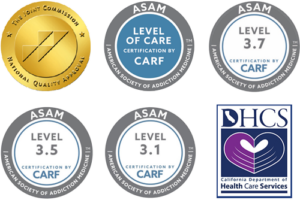Acetone. Ammonia. Sulfuric Acid. Toluene. These everyday household and industrial chemicals are effective paint thinners, fertilizers, drain cleaners and brake fluids. Inconspicuous and innocent enough on their own, they can be combined to create something much more sinister: methamphetamine. By using these and other common chemicals, this notorious drug is made from pseudoephedrine, the active ingredient in many over-the-counter decongestants. Cheap, potent and readily available, over the past few decades methamphetamine use has steadily risen in the United States, creating an epidemic that has left a trail of crime, violence and devastation in its wake. Small towns and rural communities have been particularly affected by the rise of methamphetamine, negatively impacting the health, stability and well-being of families and individuals in these areas.
Although the opioid crisis has dominated the conversation lately, methamphetamine abuse remains a problem in many parts of the country. Known for its addictive potential, undesirable side effects and correlation to crime, many users experience an extreme decrease in overall quality of life once addiction takes hold. At Journey Hillside Tarzana, we work closely with patients to explore the roots of their meth addiction and help them rediscover a brighter future, one free from the cycle of substance abuse. Our signature services include a wide range of therapeutic options for those struggling with methamphetamine addiction, providing effective treatments that give patients the tools they need to eliminate their dependence and learn how to live a healthy, sober life.
WHAT IS METHAMPHETAMINE?
Methamphetamine or meth is a highly addictive and potent stimulant that gives users an intense high, seemingly unlimited energy and a decreased need for food or sleep. Often produced in clandestine labs using a variety of hazardous chemicals, meth occurs in a powder form that resembles crystals or shards of ice and can be smoked, snorted, injected or eaten. As with other illicitly-produced substances, it’s impossible to know the quality or purity of methamphetamine, making it difficult for users to gauge how much of the drug they’re consuming or what dangerous by-products they’re ingesting in the process. This poses an extreme risk to an individual’s health and well-being, increasing the likelihood of unwanted side effects, overdose and death.
When consumed, meth acts on the central nervous system and creates a surge or rush of euphoria, followed by hours of increased activity levels, racing thoughts and an elevated mood. The methamphetamine is a long-acting drug and the high can be extended to last for days, during which time users don’t sleep and often begin to become paranoid or anxious. Severe psychological effects that include hallucinations, delusions and psychosis are not uncommon as long periods of excitability, sleep deprivation and elevated dopamine levels in the brain negatively affect one’s mental state and overall health.
SIGNS OF METHAMPHETAMINE ADDICTION
Methamphetamine overstimulates areas of the brain that control mood, sleep and energy, releasing large amounts of dopamine that create a euphoric rush and long-lasting high. While it makes users feel more confident, focused and less fearful, the high also makes them more likely to engage in risky or violent behavior. The extreme effects of meth on an individual also produce several distinct and noticeable effects, which include:
- DILATED PUPILS
- INABILITY TO SIT STILL
- INCOHERENT THOUGHT PATTERNS
- FIDGETING AND TWITCHING
- OBSESSIVE BEHAVIOR
- EXCESSIVE ENERGY
- DECREASED APPETITE
- SKIN PICKING
- MOOD SWINGS
- AGGRESSION
- ERRATIC BEHAVIOR
The long-term consequences of meth addiction use are also prominent and often include weight loss, tooth decay, malnutrition and psychiatric issues. Health problems worsen with patterns of binging and crashing, in which users consume large amounts of the drug and frequently re-dose to prevent the inevitable and brutal come down. Consistent, repeated use of the drug produces diminishing returns, creating a cycle of abuse that is difficult to escape from without professional help and guidance. At Journey Hillside Tarzana, our dedicated medical team can help patients navigate the difficulties of methamphetamine addiction with compassion and expertise, managing withdrawal symptoms and addressing the full scope of the drug’s physical, mental and emotional effects on the brain and body. From detox to residential treatment and aftercare support, our signature services guide patients through multiple stages of recovery to ensure a consistent, effective experience that provides the greatest chance at long-term sobriety.
TREATING METH AND ADDERALL ADDICTION LOS ANGELES
Methamphetamine affects the brain so strongly that overcoming an addiction to the drug is challenging. The meth high comes from extremely elevated dopamine levels, throwing off the neurochemical balance that regulates mood, energy levels, pleasure and more. Long-term use of methamphetamine depletes dopamine stores and damages receptors in the brain. When meth isn’t present to stimulate the release of dopamine, individuals often feel anxious, depressed and lethargic. Many individuals recovering from meth addiction experience a period of anhedonia — the inability to feel pleasure at all — which can last for months. These psychological symptoms linger for a long time as the brain heals, making this a difficult phase as the things that were once appealing, such as food, sex, exercise or even a favorite activity, are no longer satisfying.
The intense psychological effects produced by methamphetamine often require professional care, personalized treatments and compassionate guidance to overcome. At Journey Hillside Tarzana, our dedicated medical team helps patients successfully manage withdrawal symptoms and eliminate their physical dependence so they can focus on achieving deep and lasting recovery. Methamphetamine addiction is often addressed with a variety of therapies and treatments that support the emotional, physical and mental health needs of patients, such as:
- MEDICALLY-SUPERVISED DETOX
- MEDICATION-ASSISTED TREATMENT
- EVIDENCE-BASED PSYCHOTHERAPIES
- EXPERIENTIAL THERAPIES
- INDIVIDUAL AND GROUP COUNSELING
- THE MATRIX MODEL
- 12-STEP BASED PROGRAMS
The treatment programs at Journey Hillside draw inspiration from the 12-steps and incorporate a unique blend of traditional and holistic modalities for a deeply individualized, engaging and multidisciplinary experience. The level of care we provide goes above and beyond industry standards to give each patient the best chance at achieving sustainable sobriety and the happy, healthy life they deserve.
METH ADDICTION TREATMENT AT JOURNEY HILLSIDE TARZANA
Journey Hillside Tarzana in Los Angeles, California, is a luxury treatment center for men and women who are struggling with addiction and co-occurring mental health disorders. Our flexible treatment plans, specialized care options and multidisciplinary approach has helped numerous individuals end their dependency on meth and get their lives back on track. If you or someone you care about needs help with substance abuse, contact or call us today at 877-414-1024 to learn more about our meth addiction treatment Los Angeles programs and how they can help.
FREQUENTLY ASKED QUESTIONS (FAQ)
Is meth addictive?
Yes, methamphetamine, commonly referred to as meth, is a highly addictive stimulant. It affects the brain’s reward system, creating intense feelings of euphoria that users often seek to replicate, leading to a cycle of abuse. Meth’s addictive properties can quickly result in dependency and have a severe impact on both the physical and psychological health of the individual. When it comes to meth rehab, Los Angeles is one of the best treatment options because our services and therapies are the most qualified to treat individuals addicted to heroin, meth, or other substances that result in strong reliance and dependence.
What does meth look like?
Meth usually comes in a crystal form, often looking like shiny, bluish-white rocks or fragments, hence its street name, “crystal meth.” It can also be found in a white, odorless powder, similar to cocaine and crack – and this powder is sometimes pressed into pills. However, appearance can vary depending on its purity, additives, or how it’s manufactured.
How long does meth detox typically take?
As the leading meth addiction treatment center, California Journey Hillside clients undergo individual and comprehensive assessments to determine how long meth detox will take. That means the duration of detox will vary for each individual. Meth detoxification duration can depend on various factors, including the user’s health, the severity of addiction, and the duration of use. Typically, the acute withdrawal phase lasts about 7-10 days, but residual and emotional effects can persist for weeks or even months. It is highly recommended that detox be carried out under the supervision of healthcare professionals to manage withdrawal symptoms effectively.
How long does meth stay in your body?
When it comes to meth addiction treatment, Los Angeles treatment centers such as Journey Hillside will assess the level of dependence in order to determine how long it will take to detox the substance from the body. Meth can be detectable in the body for different periods depending on the test used. In urine samples, the substance can be detected for up to 3-5 days after use. It can be detected in blood for about 1-3 days, while in hair, it can be traceable for up to 90 days. Note that these timescales can vary based on individual metabolic rates, the quantity consumed, and the frequency of use. Recovery time is also contingent on whether or not an individual is combining meth use with other issues such as oxycodone addiction, dependence upon alcohol, or other substance use disorders.
Can you overdose on meth?
Absolutely. Overdosing on meth is a serious risk for users, especially given the unpredictable purity of street drugs. Symptoms of a meth overdose can include heart attack, stroke, organ problems, seizures, and in severe cases, it can lead to death. If you suspect someone is experiencing a meth overdose, it’s crucial to seek a meth addiction treatment program, California Journey Hillside being the ideal option for complete and long-lasting recovery.
What is meth made of?
Meth is typically made from pseudoephedrine or ephedrine, which are common in over-the-counter cold medications. The production process involves hazardous chemicals like ammonia, acetone, hydrochloric acid, red phosphorus, and lithium – substances that are incredibly dangerous to both people and the environment. This dangerous concoction contributes to the drug’s severe health risks.



